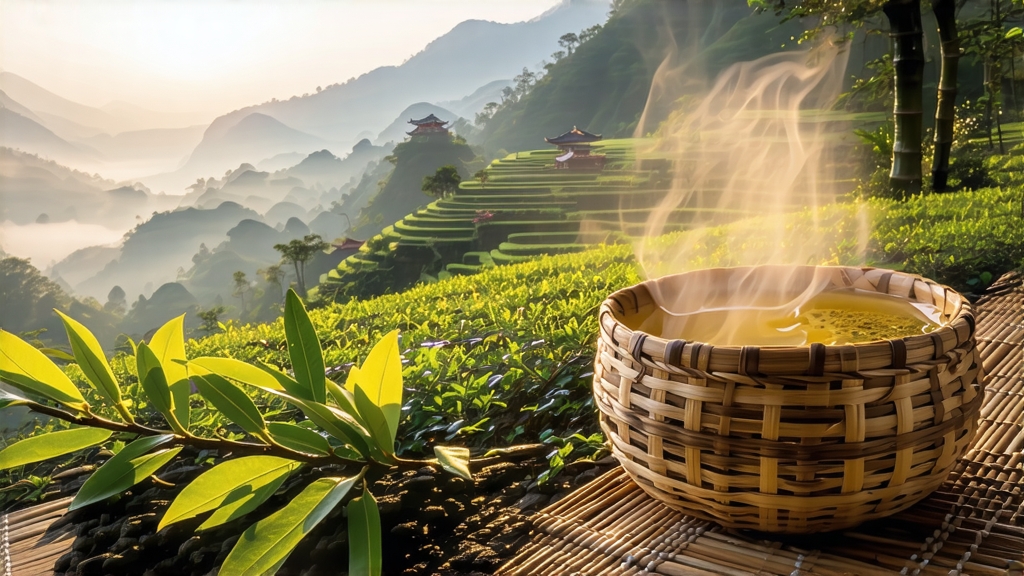
Tucked high on the northern rim of the Sichuan Basin, where the Himalayas throw their first gentle folds toward the Yangtze, lies Meng Ding Mountain—“the misty summit” that Chinese poets have celebrated for twelve centuries. At 1 450 m the peak spends more than 220 days a year wrapped in fog; the cool moisture coaxes the tea bushes into an almost languid growth, concentrating amino acids and fashioning the tiny, down-covered buds that become Meng Ding Huang Ya, the most revered yellow tea still produced in China.
Although yellow tea as a category was first recorded during the Tang dynasty (618-907 CE), Meng Ding Huang Ya enters the written record only in 808 CE, when the regional governor sent 350 grams of “small-bud yellow cake” to Emperor Xianzong. The tribute status was reaffirmed under the Song, Ming and Qing courts; the last imperial order, placed in 1908, requested only 120 grams, so scarce had the tea become. After the fall of the dynasty the craft nearly vanished—fewer than fifteen families kept the secret of the slow “sealed yellowing” step—until a small state workshop revived it in 1959. Today less than 1 200 kg reach the market each spring, most of it pre-sold to collectors in Beijing, Shanghai and Tokyo.
The cultivar itself is a local variant of Camellia sinensis var. sinensis known colloquially as “Meng Ding early fish-tail,” distinguished by an almost circular leaf base that resembles a carp’s tail. Bushes are planted in terraced pockets of yellow-brown phyllite soil so thin that roots must dive three metres before meeting groundwater; the stress limits leaf size but intensifies fragrance. No agrochemicals are used—the mountain’s perpetual cloud cover suppresses insect pressure, while fallen bamboo leaves act as a natural mulch.
Plucking occurs during the fifteen-day “yellow sprout window” that opens when five consecutive days remain below 18 °C and humidity stays above 85 %. Only the single unopened bud, still sheathed in two pale green cataphylls, is taken; experienced pickers work with thumbnail rather than finger to avoid the invisible bruise that would oxidise into a reddish “ring of death” during yellowing. The daily harvest ends at 09:30, before mountain winds rise and begin to wrinkle the tender surface.
Withering is conducted not on bamboo trays but on sheets of handmade Meng Ding paper stretched over low charcoal braziers. The temperature hovers at 28 °C for 90 minutes, just long enough to reduce moisture to 68 % while preserving the bud’s silvery down. The paper’s capillary pores absorb excess vapor, preventing the grassy notes that plague lesser yellow teas.
Fixation follows the Sichuan “flash kill-green” protocol: 260 °C for 48 seconds in an iron wok brushed with spring water. The goal is to rupture only 60 % of the cell walls, leaving enough active enzymes to drive the critical yellowing phase. Masters listen for the change in crackle—from popcorn-like to the soft “silk tear”—before sweeping the buds into a linen sack.
Rolling is minimal: eight cross-wise strokes plus four belly-wraps around the forearm. The buds must remain 85 % intact; excessive shaping would express sap and darken the liquor. What follows is the step that gives yellow tea its name—men huang, “sealed yellowing.” The wrapped buds are stacked inside a hollow cylinder of fresh Meng bamboo lined with wet goat-hide. Core temperature is allowed to climb to 38 °C for four hours, then drop to 32 °C for another twenty. During this slow respiration the chlorophyll degrades into pheophytin, catechins dimerise into theaflavins, and a honey-like aroma develops. The process is repeated three times over forty-eight hours, with re-wetting of the hide to maintain 75 % relative humidity.
Low-temperature drying finishes the tea: 55 °C for two hours in a pine-charcoal oven, then 45 °C for a final hour. The finished bud appears the colour of polished boxwood, downy tips glinting like electrum. When rubbed it releases a scent reminiscent of fresh corn silk, toasted sesame and alpine orchid.
For brewing, choose a tall cylindrical glass or a 120 ml porcelain gaiwan; both allow the buds to stand upright and “dance,” a sight the Chinese call “rain of spears.” Use 3 grams of tea—about thirty buds—to